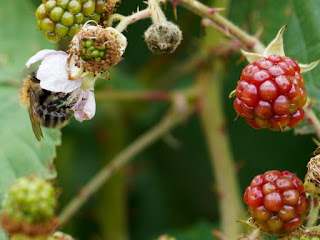This male Blackbird in the Rose Garden often comes out to ask for sultanas.
A Blackbird beside the Long Water ate blackberries.
Although the brambles are now producing ripe fruit, there are still a few flowers left for this Honeybee.
A Reed Warbler sang in the reed bed near the Italian Garden.
Below it, a Grey Heron stalked through the undergrowth. It had a stab at something, probably a rat, but missed.
The pigeon-eating Lesser Black-Backed Gull gave me a severe stare.
One of the younger Great Crested Grebe chicks on the Long Water flapped its little wings.
An older chick under the willow is already catching insects.
The Coot in the nest on the post at Peter Pan glared at a Black-Headed Gull while its mate brought fresh leaves to the nest.
A young Moorhen crossed the waterfall in the Dell.
The dominant Mute Swan at the west end of the Serpentine was in a foul mood, chasing every swan in sight.
The Greylag Geese on the Serpentine haven't been able to breed at all, probably owing to predation by foxes. Today these teenagers arrived on the lake, newly able to fly and brought in by their parents who had finished moulting and regrown their wing feathers. Geese are intelligent, and it's quite likely that the parents are park residents who assessed the hopeless situation and decided to nest in a safer place.
There is yet another brood of eight Egyptian goslings on the Serpentine. Sadly, they don't last long here, but the 'pile 'em high, sell 'em cheap' breeding strategy of Egyptians is steadily increasing their numbers.
A Pochard drake flapped his wings. He is one of three Pochards, two male and one female, who have not migrated away from the park with the others.
The blond Mallard duckling at Peter Pan is very conspicuous. So far it has avoided the gulls.














I wonder if the little blond mallard will look like the adult blond mallard we have seen in previous entries when it grows up.
ReplyDeleteLook at those precious teeny tiny little wings! It could melt a heart of stone.
I'm undecided about the placement of Pigeon Eater's eyes. Are they placed more frontally than in other gulls?
I think Pigeon Eater's eyes are in the normal position for gulls, just able to overlap their field of view dead ahead. Binocular vision as humans understand it is not as important for birds as it is for us. Their heads are small and their eyes are close together, so there is not much to give them a stereoscopic view. Instead they rely on parallax caused by motion -- their own or that of prey -- to give them information about depth. That is why, for example, Little Owls bob their heads when they are looking at something.
Delete